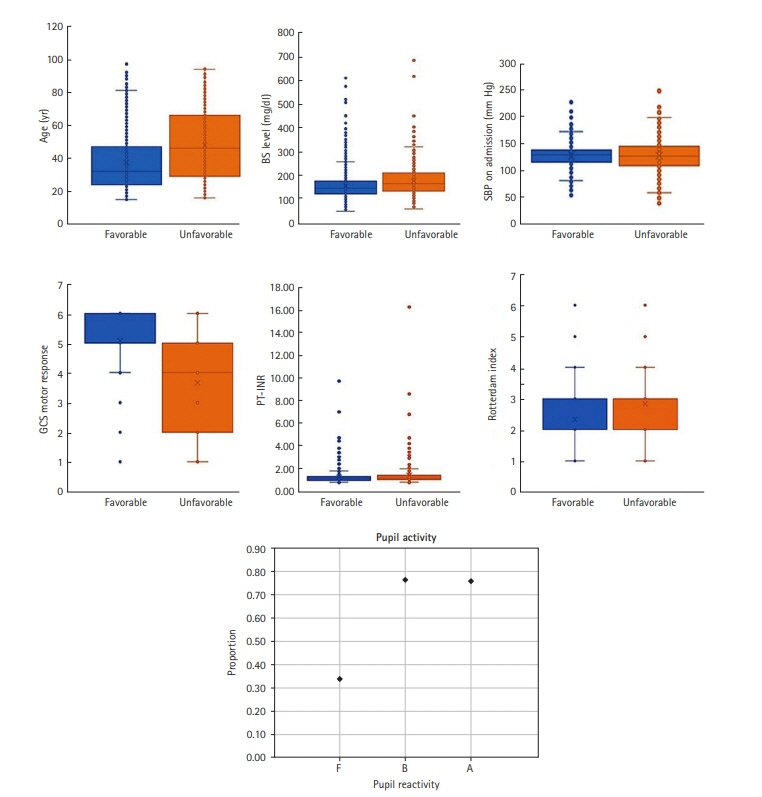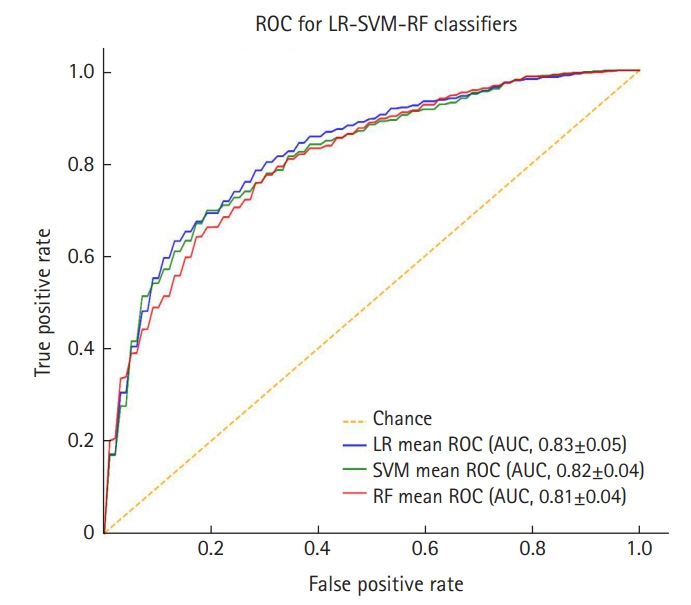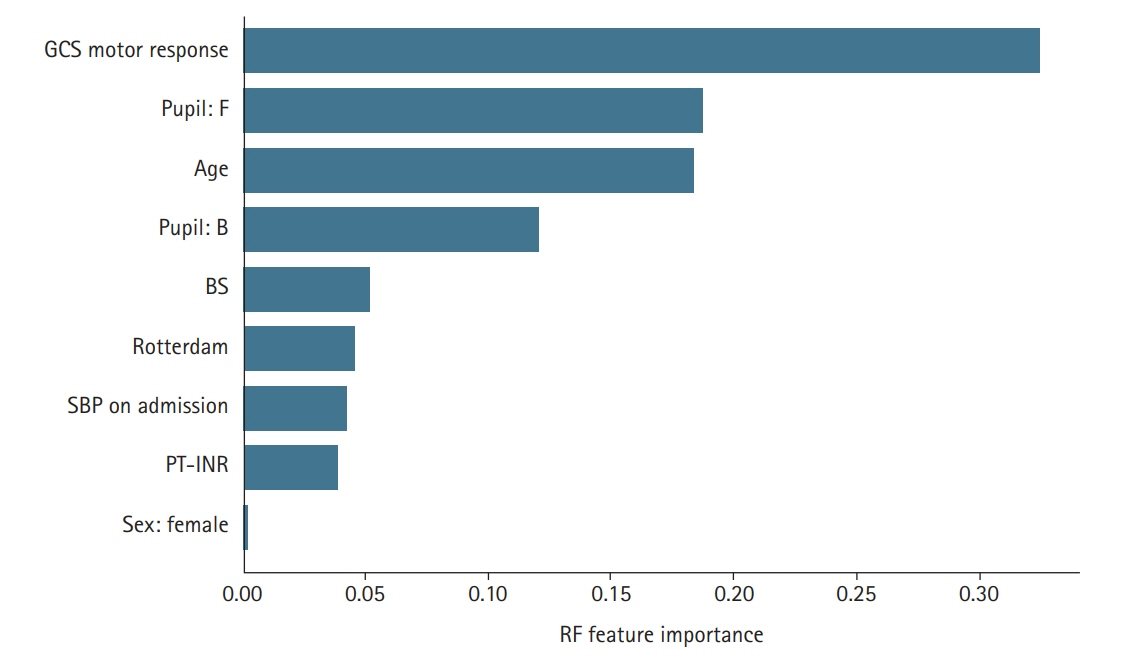Acute Crit Care.
2022 Feb;37(1):45-52. 10.4266/acc.2021.00486.
A machine learning model for predicting favorable outcome in severe traumatic brain injury patients after 6 months
- Affiliations
-
- 1Department of Computer Science, University of Wyoming, Laramie, WY, USA
- 2Department of Electrical Engineering, Sharif University of Technology, Tehran, Iran
- 3Trauma Research Center, Shahid Rajaee (Emtiaz) Trauma Hospital, Department of Neurosurgery, Shiraz University of Medical Sciences, Shiraz, Iran
- 4Department of Medical Physics and Engineering, School of Medicine, Shiraz University of Medical Sciences, Shiraz, Iran
- 5Shiraz Neuroscience Research Center, Shiraz University of Medical Sciences, Shiraz, Iran
- KMID: 2527906
- DOI: http://doi.org/10.4266/acc.2021.00486
Abstract
- Background
Traumatic brain injury (TBI), which occurs commonly worldwide, is among the more costly of health and socioeconomic problems. Accurate prediction of favorable outcomes in severe TBI patients could assist with optimizing treatment procedures, predicting clinical outcomes, and result in substantial economic savings. Methods: In this study, we examined the capability of a machine learning-based model in predicting “favorable” or “unfavorable” outcomes after 6 months in severe TBI patients using only parameters measured on admission. Three models were developed using logistic regression, random forest, and support vector machines trained on parameters recorded from 2,381 severe TBI patients admitted to the neuro-intensive care unit of Rajaee (Emtiaz) Hospital (Shiraz, Iran) between 2015 and 2017. Model performance was evaluated using three indices: sensitivity, specificity, and accuracy. A ten-fold cross-validation method was used to estimate these indices. Results: Overall, the developed models showed excellent performance with the area under the curve around 0.81, sensitivity and specificity of around 0.78. The top-three factors important in predicting 6-month post-trauma survival status in TBI patients are “Glasgow coma scale motor response,” “pupillary reactivity,” and “age.” Conclusions: Machine learning techniques might be used to predict the 6-month outcome in TBI patients using only the parameters measured on admission when the machine learning is trained using a large data set.
Keyword
Figure
Reference
-
1. Nguyen R, Fiest KM, McChesney J, Kwon CS, Jette N, Frolkis AD, et al. The international incidence of traumatic brain injury: a systematic review and meta-analysis. Can J Neurol Sci. 2016; 43:774–85.
Article2. Prins M, Greco T, Alexander D, Giza CC. The pathophysiology of traumatic brain injury at a glance. Dis Model Mech. 2013; 6:1307–15.
Article3. Werner C, Engelhard K. Pathophysiology of traumatic brain injury. Br J Anaesth. 2007; 99:4–9.
Article4. Weir J, Steyerberg EW, Butcher I, Lu J, Lingsma HF, McHugh GS, et al. Does the extended Glasgow Outcome Scale add value to the conventional Glasgow Outcome Scale? J Neurotrauma. 2012; 29:53–8.
Article5. Hale AT, Stonko DP, Lim J, Guillamondegui OD, Shannon CN, Patel MB. Using an artificial neural network to predict traumatic brain injury. J Neurosurg Pediatr. 2018; 23:219–26.
Article6. Hale AT, Stonko DP, Brown A, Lim J, Voce DJ, Gannon SR, et al. Machine-learning analysis outperforms conventional statistical models and CT classification systems in predicting 6-month outcomes in pediatric patients sustaining traumatic brain injury. Neurosurg Focus. 2018; 45:E2.
Article7. Ledig C, Heckemann RA, Hammers A, Lopez JC, Newcombe VF, Makropoulos A, et al. Robust whole-brain segmentation: application to traumatic brain injury. Med Image Anal. 2015; 21:40–58.
Article8. Gong T, Ambastha AK, Tan CL, Su B, Lim TC. Automated prognosis analysis for traumatic brain injury CT images. In : Proceedings of 2015 3rd IAPR Asian Conference on Pattern Recognition (ACPR); 2015 Nov 3-6; Kuala Lumpur, Malaysia. p. 386–90.
Article9. Agoston DV, Langford D. Big Data in traumatic brain injury; promise and challenges. Concussion. 2017; 2:CNC45.
Article10. Folweiler KA, Sandsmark DK, Diaz-Arrastia R, Cohen AS, Masino AJ. Unsupervised machine learning reveals novel traumatic brain injury patient phenotypes with distinct acute injury profiles and long-term outcomes. J Neurotrauma. 2020; 37:1431–44.
Article11. Matsuo K, Aihara H, Nakai T, Morishita A, Tohma Y, Kohmura E. Machine learning to predict in-hospital morbidity and mortality after traumatic brain injury. J Neurotrauma. 2020; 37:202–10.
Article12. Shi HY, Hwang SL, Lee KT, Lin CL. In-hospital mortality after traumatic brain injury surgery: a nationwide population-based comparison of mortality predictors used in artificial neural network and logistic regression models. J Neurosurg. 2013; 118:746–52.
Article13. Klemenc-Ketis Z, Bacovnik-Jansa U, Ogorevc M, Kersnik J. Outcome predictors of Glasgow Outcome Scale score in patients with severe traumatic brain injury. Ulus Travma Acil Cerrahi Derg. 2011; 17:509–15.
Article14. Rughani AI, Dumont TM, Lu Z, Bongard J, Horgan MA, Penar PL, et al. Use of an artificial neural network to predict head injury outcome. J Neurosurg. 2010; 113:585–90.
Article15. Eftekhar B, Mohammad K, Ardebili HE, Ghodsi M, Ketabchi E. Comparison of artificial neural network and logistic regression models for prediction of mortality in head trauma based on initial clinical data. BMC Med Inform Decis Mak. 2005; 5:3.
Article16. Pourahmad S, Rasouli-Emadi S, Moayyedi F, Khalili H. Comparison of four variable selection methods to determine the important variables in predicting the prognosis of traumatic brain injury patients by support vector machine. J Res Med Sci. 2019; 24:97.
Article17. Demetriades D, Kuncir E, Velmahos GC, Rhee P, Alo K, Chan LS. Outcome and prognostic factors in head injuries with an admission Glasgow Coma Scale score of 3. Arch Surg. 2004; 139:1066–8.
Article18. Guyon I, Elisseeff A. An introduction to variable and feature selection. J Mach Learn Res. 2003; 3:1157–82.19. Hastie T, Tibshirani R, Friedman J. The elements of statistical learning: data mining, inference, and prediction. Second edition [Internet]. Springer-Verlag;New York (NY): 2009. [cited 2021 Sep 10]. Available from: //www.springer.com/gp/book/9780387848570.20. Probst P, Wright MN, Boulesteix AL. Hyperparameters and tuning strategies for random forest. WIREs Data Min Knowl Discov. 2019; 9:e1301.
Article21. Liaw A, Wiener M. Classification and regression by randomforest. R news. 2002; 2:18–22.22. Cortes C, Vapnik V. Support-vector Networks. Mach Learn. 1995; 20:273–97.
Article23. Bennis FC, Teeuwen B, Zeiler FA, Elting JW, van der Naalt J, Bonizzi P, et al. Improving prediction of favourable outcome after 6 months in patients with severe traumatic brain injury using physiological cerebral parameters in a multivariable logistic regression model. Neurocrit Care. 2020; 33:542–51.
Article24. Rubin ML, Yamal JM, Chan W, Robertson CS. Prognosis of six-month Glasgow Outcome Scale in severe traumatic brain injury using hospital admission characteristics, injury severity characteristics, and physiological monitoring during the first day post-injury. J Neurotrauma. 2019; 36:2417–22.
Article25. Haveman ME, Van Putten MJ, Hom HW, Eertman-Meyer CJ, Beishuizen A, Tjepkema-Cloostermans MC. Predicting outcome in patients with moderate to severe traumatic brain injury using electroencephalography. Crit Care. 2019; 23:401.
Article
- Full Text Links
- Actions
-
Cited
- CITED
-
- Close
- Share
- Similar articles
-
- Use of Machine Learning in Stroke Rehabilitation: A Narrative Review
- The Relationship Between Trauma Scoring Systems and Outcomes in Patients With Severe Traumatic Brain Injury
- Animal Models of Traumatic Brain Injury
- Diagnostic Accuracy of Machine Learning Algorithms for Hepatitis A Antibody
- Does the Size of Unilateral Decompressive Craniectomy Impact Clinical Outcomes in Patients with Intracranial Mass Effect after Severe Traumatic Brain Injury?




